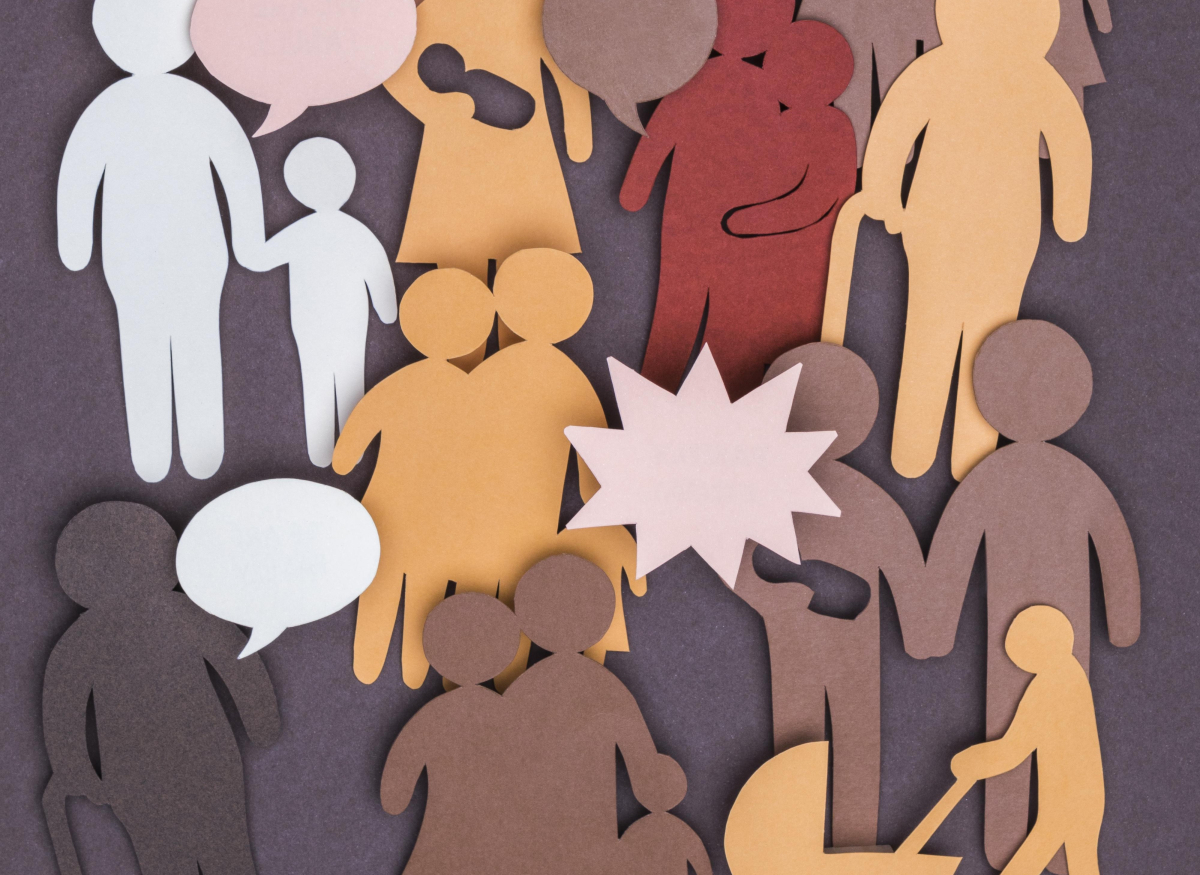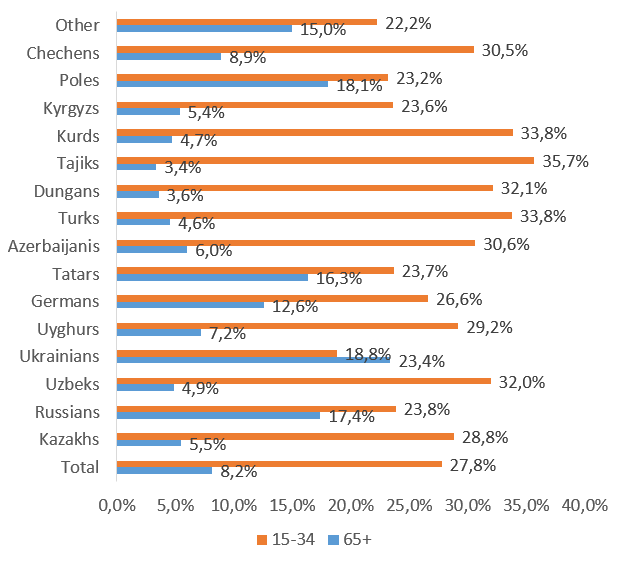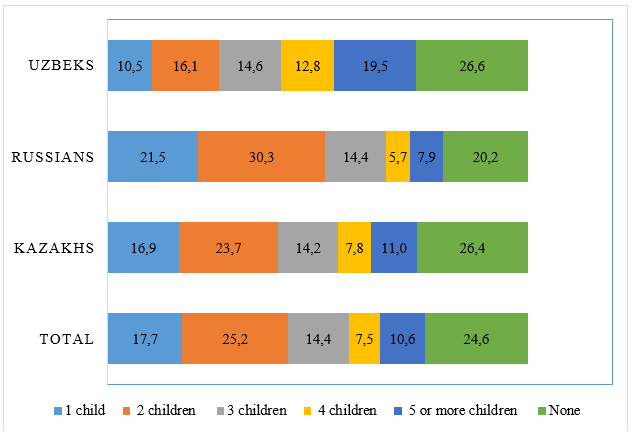
Population censuses in the world, including Kazakhstan, are conducted once every ten years. In independent Kazakhstan, National Population Censuses were conducted three times: in 1999, 2009 and 2021.
One of the main advantages of the population census as a source of information compared to current records is the update of the de-facto population, determining the ethnic composition of the population and the age structure of ethnic groups and family size. Based on the results of the population census, it is possible to assess the future reproductive behavior of the population.
In assessing the sphere of interethnic relations, it is the ethno-demographic situation that is one of the important parameters.
According to the results of the latest National Population Census of 2021 (hereinafter referred to as the Population Census), the population of Kazakhstan was 19,186,015 people, representatives of 124 ethnic groups live in the country (based on the results of 2009 - 125) [1].
For the intercensus period 2009-2021. the number of Kazakhs increased by 33.7% (share of 70.4%) , Uzbeks - 33.4% (share of 3.2%), Russians decreased by 21.4% (share of 15.5%) 1 .
The high level of natural growth led to the fact that in two years the country's population increased by 1 million people: on November 14, 2023, the population of the Republic of Kazakhstan reached 20 million people. According to the population database, 5 children born at 8.10 am on November 14, 2023 became the 20 millionth population of the country. Jubilee citizens of Kazakhstan were born in the regions of Ulytau and Zhetisu, Atyrau, Akmola and Turkestan regions. Among them are 3 boys and 2 girls [2].
The demographic potential of Kazakhs and other Asian ethnic groups (Uzbeks, Dungans, Kurds, Tajiks, Uighurs, Turks) is much higher than European ones. Among European ethnic groups, the rate of population aging is much higher than among Asian ethnic groups. According to the Population Census, among the main ethnic groups living in Kazakhstan, the highest level of population aging is observed among Ukrainians (23.4%), Poles (18.1%) and Russians (17.4%).
Kazakhs are a relatively young ethnic group and the proportion of the elderly population over 65 years old was 5.5% of the total population, and the share of youth was 28.8%.
More than 1/3 of the Tajiks (35.7%), Turks and Kurds (33.8%) are young people, almost 1/3 of the Dungans (32.1%) and Uzbeks (32.0%) are also young people. The least number of young people in the age group 15-34 years old are Ukrainians (18.8%), Poles (23.2%) and Kyrgyz (23.6%) (Figure 1).

Figure 1. Share of youth (15-34 years old) and elderly population (65+) among ethnic groups, in%
Source: statistical collection “National composition, religion and language proficiency in the Republic of Kazakhstan. Results of the National Population Census 2021 in the Republic of Kazakhstan", Astana, 2023.
The number of families during the intercensus period increased by 38.7%, but family size decreased from 3.5 to 3.2. The number of families according to the results of the Population Census was 5,578,947, of which the number of families with children was 3,633,869, including the number of families with more than 10 children - 163.
Families of two people account for 41.2%, of three – 27.6%, of four – 14.9%, of five – 8.2%, of six – 4.5%, of seven – 1.7%, out of eight – 0.8%, out of nine – 0.4%, out of ten or more people – 0.7%.
In Kazakhstan, 30.4% of men and 25.7% of women have never been married, 58.9% of women and 63.1 % of men are married, and of these, 52.4% of women and 57.0% men's marriage is officially registered. Cohabitation is most common among women - 6.5% of women and 6.1% of men - the marriage is not registered. Marriage was dissolved in 4.5% of men and 7.0% of women. Widows - 8.4%, and widowers - 2.0%.
30.4% of Kazakhs and 25.7% of Kazakh women have never been married, for Uzbeks this figure is 32.8% and 30.1%, for Russians - 27.4% and 22.7%, respectively. 56.7% of Kazakhs and 53.0% of Kazakh women, 55.5% of Uzbeks and 52.5% of Uzbek women, and 58.0% of Russian men and 51.3% of Russian women are in registered marriages. Cohabitation is more common among Uzbeks: 10.0% of women and 7.6% of men of this ethnic group are in unregistered marriages, among Kazakhs - 6.4% of men and 6.9% of women, among Russians 5.0% of men and 4. 9% women.
According to the ethnic groups under consideration, there are more widows than widowers, especially among Russians - 12.8% of Russian women are widows. 6.9% of Kazakh women and 3.7% of Uzbek women noted that they had lost their husbands, and 1.7% of Kazakhs, 2.9% of Russians and 2.2% of Uzbeks lost their wives. This imbalance between the three ethnic groups is associated with the level of aging, since it is higher among Russians, and therefore their mortality rate is also higher compared to the Kazakhs and Uzbeks. Divorce is more common among Russians, regardless of gender.
The results of the Population Census show that women in Kazakhstan are gradually moving towards having few children. There are 1,024,911 women in the age group 15-49 years old planning to have children, which is 22.6% of all women in this age group. Among women planning children, there is a very low proportion of those who strive to have many children: the proportion of women who want/plan to have 4 children is 12.3%, 5 or more children - 6.0%. 17.4% of women want 3 children. The largest proportion of women want to have 1 child - 35.9%, 2 children - 28.4%.
At young reproductive age (15-24 years) and middle reproductive age (25-34 years), women are most likely to give birth to 1-2 children. In the age group of 45-49 years, 63.8% of women are planning 1 child and 36.2% - 2 children.
Among age groups, the largest proportion planning to have children is the age group of 35-39 years (33.4%) - this is the generation of women born at the time of the census in the period between 1982-1986, the smallest is in the age group 45-49 years (7. 1%) - this is due to the fact that in this age group women mainly complete their reproductive functions. The fact that in the age groups of 15-19 years and 20-24 years there is a relatively low level of planning for the birth of children also contributes to a decrease in the birth rate in the future.
The number of women who indicated the number of children born according to the results of the Population Census is 7.1 million people. Of these, those who indicated that they do not have children are 24.6% (Kazakh women - 26.4%, Uzbeks - 26.6% and Russians 20.2%). In all three ethnic groups, the majority of women have two children. If Kazakh women and Russians have mostly 1-2 children, then Uzbek women have 3-5 children each. 17.7% of women have one child; in terms of ethnicity, Russians have the most one child – 21.5% (Figure 2).

Figure 2. Share of women by number of children born according to the results of the Population Census
Source: statistical collection “Marriage and Family. Results of the National Population Census 2021 in the Republic of Kazakhstan", Astana, 2023.
In general, the results of the Population Census show that despite the fact that there is an increase in the population, there are differences in ethnicity. Thus, Kazakhs and Asian ethnic groups tend to increase during the intercensal period, and European ethnic groups tend to decrease in population. this is primarily due to the age structure of the population and reproductive behavior: European ethnic groups, including Russians, have a high level of population aging and are prone to having few children, and Asian ethnic groups, such as Uzbeks, Tajiks, Dungans and others, have more youth in their age structure and On average, they have two to three children. The high level of population aging among European ethnic groups also leads to high mortality among them and, as a result, they have more widows and widowers than Asian ethnic groups.
It is also worth noting the fact that, as a result of this Population Census, it was possible to determine not only the reproductive behavior of the population, but also to find out marital status - 6.5% of women and 6.1% of men in Kazakhstan live in an unregistered marriage. Perhaps this indicates a change in attitude towards official marriage as the only possible way to create a family.
In general, it is worth noting that the population census is the only unique source of information about changes in the ethno-demographic structure of the population, which makes it possible to make forecasts for various spheres of life of the population and improve the socio-economic and interethnic policies of the country.
[1] https://stat.gov.kz/ru/national/2021/
[2] https://stat.gov.kz/ru/news/chislennost-naseleniya-kazakhstana-dostigla-20-millionov/